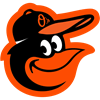Welcome to the fifth day of regular-season games. The early season has seen things crazier than most expected with the Baltimore Orioles running wild on the bases, Joey Gallo kicking off a comeback tour and some crazy early run differentials as teams adjust to the new world order created by Major League Baseball.
It's still early, and I'll have more on this next week, but we may indeed be in for a resurgence of power this year after a down year in 2022. You will recall that the first seven to 10 games give us a strong indicator of what the season will be like for home runs. The early data as play began on April 5th shows a few interesting trends around a potential offensive resurgence this season. I'll feel more confident making an overall season homer total prediction next week along with some potential 20/20 and 30/30 targets, but for now, this is what the opening five days have shown us.
Baseballs Are Traveling Farther
It's not just your imagination or eyes your deceiving you while watching games this season. 3.1 percent of all plate appearances have resulted in a home run league-wide this season. The early average flyball distance shows that flyballs are averaging 311 feet, which is the same as it was for the entirety of March/April 2022 as the weather warmed up over the month. This will be something to watch, as this number will only go up as temperatures rise around the league this
Welcome to the fifth day of regular-season games. The early season has seen things crazier than most expected with the Baltimore Orioles running wild on the bases, Joey Gallo kicking off a comeback tour and some crazy early run differentials as teams adjust to the new world order created by Major League Baseball.
It's still early, and I'll have more on this next week, but we may indeed be in for a resurgence of power this year after a down year in 2022. You will recall that the first seven to 10 games give us a strong indicator of what the season will be like for home runs. The early data as play began on April 5th shows a few interesting trends around a potential offensive resurgence this season. I'll feel more confident making an overall season homer total prediction next week along with some potential 20/20 and 30/30 targets, but for now, this is what the opening five days have shown us.
Baseballs Are Traveling Farther
It's not just your imagination or eyes your deceiving you while watching games this season. 3.1 percent of all plate appearances have resulted in a home run league-wide this season. The early average flyball distance shows that flyballs are averaging 311 feet, which is the same as it was for the entirety of March/April 2022 as the weather warmed up over the month. This will be something to watch, as this number will only go up as temperatures rise around the league this month:
SEASON (March/April) | FLYBALLS | AVG DISTANCE |
2016 | 3,803 | 316 ft |
2017 | 4,155 | 320 ft |
2018 | 4,987 | 318 ft |
2019 | 5,101 | 321 ft |
2021 | 4,663 | 318 ft |
2022 | 4,018 | 311 ft |
2023 | 1,050 | 311 ft |
We have already had some impressive projected distance blasts this season, topped by (shocker) Giancarlo Stanton with a projected blast of 485 feet on Sunday. We've also seen Jason Vosler hit a ball projected to go 444 feet and even Matt Duffy hit one a projected 430 feet; the same Duffy who hit just two home runs in 2022 took Jovani Moran into the fountains.
Less Drag on the Baseball
BaseballSavant now has a drag dashboard so we can see how the ball is performing using a method developed by Alan Nathan and David Kagan. They have drag data dating back to 2016, which shows that some strange things are afoot at the Circle K these days. Early data is showing less draft on the baseball to date, and less drag means more distance traveled by the baseball:

It's great that the site gives us immediate transparency. We've previously had to wait for articles to come out which research the ball and show us that multiple baseballs have been used around the league. The early data points show something more like 2021 if not potentially 2019 as this month moves on. This is a data point worth revisiting on a weekly basis to see what happens as spring finally makes its way into the parts of the country where Old Man Winter is refusing to leave.
Starters Are Struggling
Where we once referred to horrible outings as being "Gombered", poor Austin may have more company this year the way the likes of Chris Bassitt, Jose Berrios, Shintaro Fujinami, Josh Fleming and others have begun the season. Here's how the league as a whole stacks up with pitching when looking at the split between starters and relievers:
ROLE | IP | HR/9 | K-BB% | AVG | WHIP | BABIP | wOBA |
Starters | 781.1 | 1.4 | 14% | .260 | 1.37 | .306 | .334 |
Relievers | 614.0 | 1.0 | 13% | .237 | 1.29 | .282 | .307 |
All pitchers have to deal with the new rules, but starting pitchers appear to be feeling the pinch more early on. Starters have to worry about controlling the running game more because they can't always go for the strikeout like a reliever can, as relievers are usually only in the game for that particular inning. Starters also must work to conserve their stuff for a longer appearance than relievers, who typically come out to throw 15-20 pitches in an appearance if all goes well.
The assumption would naturally be that pitchers are tiring earlier in the game because of the reduction in recovery time between pitches, yet the times through the order (TTO) data tells a different story thus far:
TTO | IP | HR/9 | K-BB% | AVG | WHIP | BABIP | wOBA |
| 1st | 321 | 1.5 | 16% | .274 | 1.49 | .338 | .346 |
| 2nd | 329 | 1.2 | 13% | .242 | 1.23 | .276 | .311 |
| 3rd | 129 | 1.8 | 12% | .268 | 1.48 | .306 | .360 |
Sure, the third time through penalty is holding up strong (unless your name is Sandy Alcantara and you can go out and throw a Maddux and finish a game in under two hours) but notice how starters are literally off to a rough start. The starters who are able to stay in the game are doing much better the second time through the order, so the inclination to blame the struggles on earlier fatigue may be misplaced. I don't have the answer as to why we're seeing so much offense the first time through the lineup while things settle down the second time through, because that's typically not how the TTO penalty works. Even looking at some of the aforementioned names show that these pitchers aren't losing velocity rapidly within a game, although some of them are down a bit from their average velocities last season:
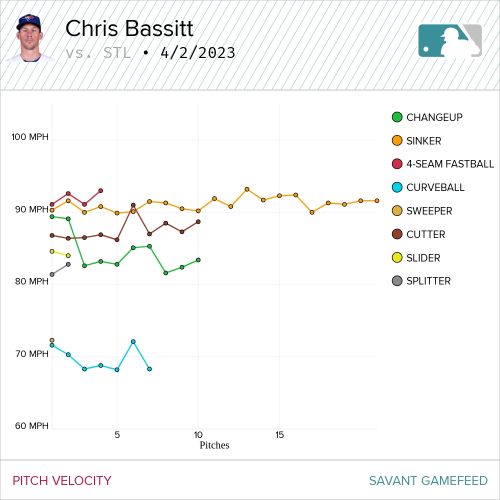
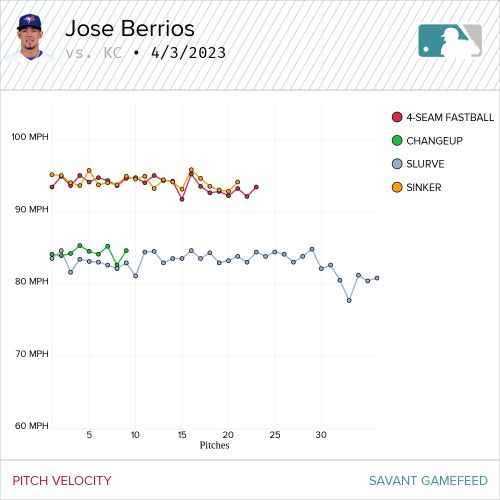
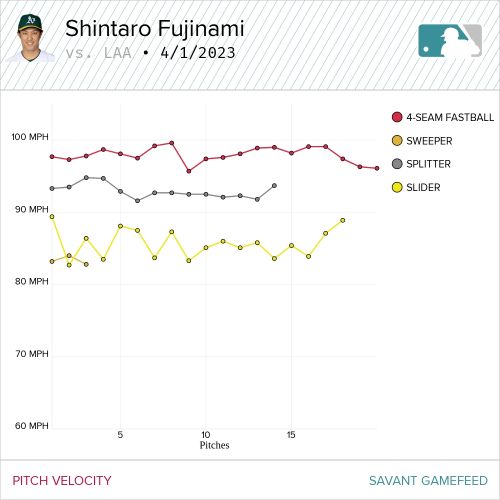
In short, baseball is off to a surprising offensive start. We expected the steals to be there based off what we witnessed in spring training, but not only are we seeing more steals, we're also seeing more homers early on. The leaguewide HR/Contact (HR/(AB-K)) is currently up 30 percent over last March/April and is back to its 2021 levels:
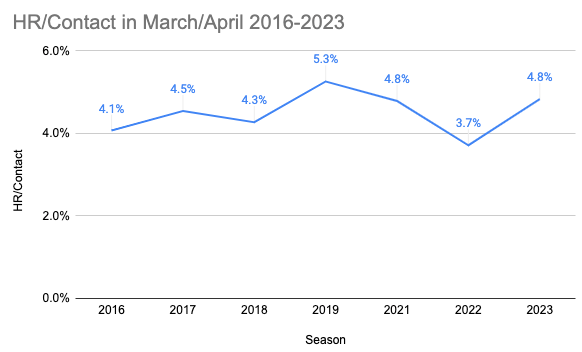
If the warm temperatures get here soon and the ball starts to go a bit further, we could be potentially witnessing the return of 2019 level offensive production in the league. Come back next week for more!













